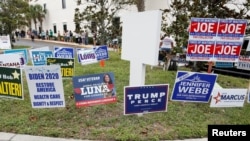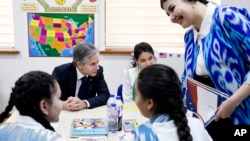Student Union
- By Esha Sarai
Record Numbers of Millennials Run for Public Office

Millennials comprise a large, diverse and important part of the U.S. electorate this year. But they are also an increasing portion of candidates for local and state elections.
According to the Millennial Action Project (MAP), an organization tracking young people running for office across the country, record numbers of people under 45 are running for office this year.
“It blew us away, because from 2018 to 2020, we've tracked to 266% increase... in the number of people who threw their hat in the ring,” Layla Zaidane, executive director and COO of MAP, told VOA.
“On Election Day, on the ballot, we'll have 259 total. Millennials just running for congressional seats,” she added.
With issues such as climate change and wage stagnation at the forefront of people’s minds, many millennial candidates say they want a hand in shaping policy that will affect their future.
“The reality is that the consequences and ramifications of the decisions that are being made will be felt by us,” David Kim, who is running as a Democrat for California’s 34th House seat, which includes Los Angeles, told VOA. “So, wouldn't it make sense for us to legislate for our future?”
The increase in millennials running for office spans almost equally across both parties. According to MAP, 40% of candidates under 45 running for the House of Representatives are Republicans.
But this generation is more likely than any other to identify as independent — or at least not fit neatly into the ideological box of either party.
“I'm not a huge fan of the two-party system,” said Luke Negron, a 27-year-old candidate in Pennsylvania’s 18th District, which includes Pittsburgh. “But my opponent is a Democrat, so I have to run as a Republican for a viable campaign.”
He added, “That doesn't mean that I think that all Republicans are good guys. And it certainly doesn't mean that I think that the only elitist sellouts are Democrats.”
In California, House seats have general or nonpartisan primaries, meaning two people of the same party can be the candidates on general Election Day.
Kim, 36, said part of what drove him to run was working on the campaign of Kenneth Mejia — a Green Party candidate for the same congressional district in 2018 who lost with just under 30% of the vote.
Though Kim’s ideology aligns with that of the Green Party candidate, he said he chose to run as a Democrat, noting “the distinction between corporately funded Democrats and people power Democrats.”
Zaidane thinks young people’s tendency to blur party lines is not only an advantage to their own campaigns but the future of policymaking.
“I think that represents a huge opportunity for this generation to exercise that ability to collaborate and innovate outside of traditional frameworks and actually solve problems,” she said.
Before serving in the U.S. Air Force, Negron balanced multiple service jobs, — “classic millennial stuff,” he told VOA.
Though technically on opposite sides of the aisle, both Negron and Kim talk about the same experience, and the same struggle — working multiple jobs to make ends meet.
“There's political grandstanding. There's moral power grabbing. And all of this really leads, ultimately, to the working class and the lower class being the ones who get hurt,” Negron said.
Zaidane said there are many policy issues, including the urgency of the COVID-19 pandemic, which have contributed to a growing number of younger candidates running for office.
The pandemic in particular has provided a unique opportunity to young candidates. In a time where large gatherings are banned for safety and people are confined to their homes, young candidates generally possess the unique advantage of knowing how to campaign online — specifically through social media.
“We have started to understand how our actions can now lead to change, and how we can leverage technology and leverage the power of social media to do that,” Zaidane said. She cited the 2018 March for Our Lives rally, which was organized by students following the mass shooting at Marjory Stoneman Douglas High School in Parkland, Florida.
“And of course, in a COVID era, where young people are running for office, that gives them a massive edge,” she added.
Kim, who has been endorsed by former Democratic presidential candidates Andrew Yang and Marianne Williamson, laughed heartily when he recounted his staff of two people when he filed to run for Congress. His volunteer base now includes over 200 people making phone calls and sending texts.
“Laughing is a sign of my disbelief,” he said.
Whether these candidates will join previous waves of young politicians in the House of Representatives will be decided this week.
See all News Updates of the Day
- By VOA News
Michigan State international students get their own space

Michigan State University in East Lansing, Michigan, is setting aside a space in the International Center for international students.
Nidal Dajani, vice president of the school's International Student Association, said that the club plans to use the space to host events and hopes to collaborate with other student groups.
- By Dylan Ebs
International students find community during Pride Month

For LGBTQ+ international students, Pride Month, observed in June, is a unique time to reflect.
They hold on to multiple identities — both their LGBTQ+ identity and their cultural background — but coming to terms with them is not always easy.
For graduate student David Zhou, these identities can feel conflicting as transgender rights in China remain a controversial issue and spaces for LGBTQ people close. Zhou, 25, is transgender and pursuing an education in the STEM field at an urban university in the Midwestern United States.
VOA is using a pseudonym for Zhou’s first name and is not naming his university to protect his identity due to safety concerns back home in China. Zhou is not open about his transgender identity to his family.
During Pride Month, Zhou said he attended multiple LGBTQ+ events in his community and is surrounded by a supportive group of LGBTQ+ students who can relate to his experiences. But he’s not open about his identity to everyone on campus and said he doesn’t disclose his preferred pronouns to everyone to avoid transphobic comments.
“I feel like I have to make some judgments of the character of that person to see if they’re a good person to disclose [my identity] to,” Zhou said.
Zhou’s Pride Month celebrations included attending local markets with LGBTQ+ vendors and hanging out with his LGBTQ+ friends.
“They normalized being trans and for a long time I feel like trans identity is, should I say a vulnerability, brings me fear and worrying about discrimination, but having those events are helpful because it allowed me to see that queer people could just [live] openly,” he said.
At social events where few international students are present, Zhou said it can be tough to fit in.
“There's a lot of times like when they were talking about things I kind of, don't really understand, mostly because I kind of lack some background experience or knowledge,” he said.
Zhou said he is not aware of specific groups for LGBTQ+ international students at his university, but said international students are more prevalent in graduate programs and therefore find representation in organizations for LGBTQ+ graduate students.
In China, transgender individuals must obtain consent from an “immediate family member,” even for adults hoping to transition, which critics say limits the autonomy of transgender individuals while supporters say the policy protects doctors from violence by upset parents.
Struby Struble, a former coordinator of the University of Missouri LGBTQ+ Resource Center, told NAFSA: Association of International Educators in 2015 that LGBTQ+ international students face a “double barrier” on campus.
“With their international student friends, they feel isolated because they’re the LGBT one,” she said. “But then among the LGBT students on campus, they feel isolated because they’re the international one.”
Nick Martin, associate director of the Q Center, Binghamton University’s LGBTQ+ student support office, said when international students tour the center, there’s often a sense of hesitation as they enter a type of space that may not be present in their home country.
“I compare that to a year in after they've come into the space, they've again, maybe come to some of our events, they've got more connected,” he said.
Martin said graduate students have a unique interest in the Q Center as they may use the office for research and advocacy purposes that align with their studies.
“For older students, there may be hesitancy in a different way, but I think it's more in the vein of they want to do some of the advocacy work,” he said.
Martin said he thinks about how both his office and BU’s international student office can support students who come from countries with few — if any — protections for LGBTQ+ individuals.
“It's been a learning process of what those students really need, but I think I've kind of learned that a lot of students are just looking for the safe space that we offer,” Martin said.
- By VOA News
International students discuss US campus culture shock

International students at De Anza College in Cupertino, California, talked about culture shock in an article in La Voz News, the student newspaper.
"It felt like a major culture shock. Everything was so different, from academics to mannerism," said a student from Mexico.
Read the full story here.
These are the most expensive schools in the US

High tuition costs along with housing and food expenses can add up for students at U.S. colleges and universities.
MSNBC looked at the most expensive schools in the country, with one costing more than $500,000 for a bachelor’s degree. (June 2024)
Uzbekistan students admitted into top US universities

Students from Uzbekistan are among the international students admitted to top colleges and universities in recent years.
Gazata.uz profiled some of the Uzbekistan students attending Harvard, Brown, Princeton and other U.S. universities. (June 2024)









